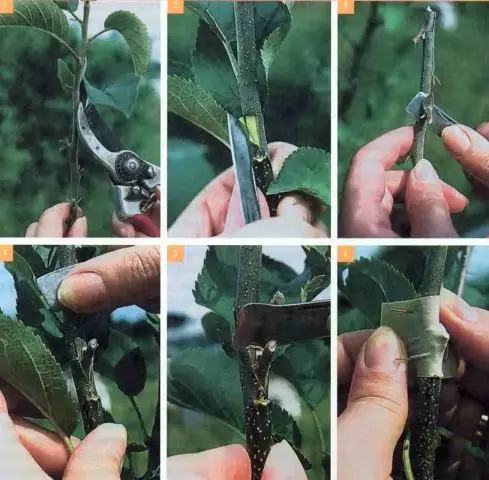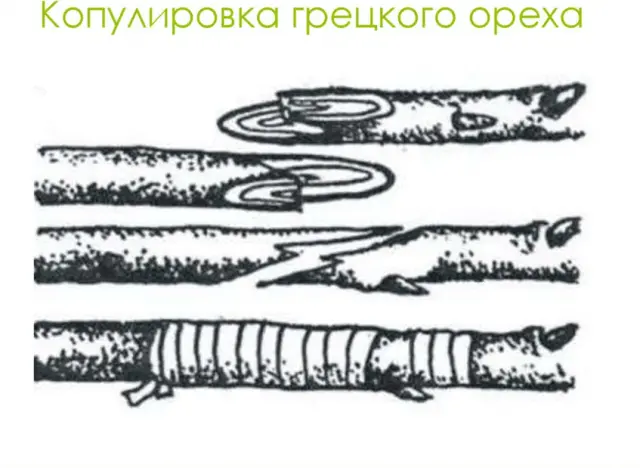Contents
The walnut grows and develops slowly, so the first fruits can be tasted 5-6 years after planting. You can speed up the process, but for this you need to learn how to propagate a tree. There are 2 most effective ways to graft a walnut that allow you to enjoy delicious kernels after 3 years.
Is it possible to graft a walnut
In addition to the fact that the walnut develops slowly, it has one more feature – during seed propagation, the varietal characteristics of the tree are not preserved. Therefore, it is possible and necessary to graft a walnut. This method allows you to grow a seedling identical to the parent, which will begin to bear fruit much earlier.
Grafting walnut seedlings is practically no different from propagating fruit crops by this method, but it has some nuances:
- For the stock, varietal seedlings of a young walnut are chosen, which are not yet 3 years old.
- The rootstock diameter should not exceed 1,5 cm.
- Young shoots of this year, cut from well-bearing trees, are suitable for grafting.
- The thickness of the scion branch in diameter should not exceed 0,8 cm.
The rootstock variety should be well combined with the scion and have the same frost resistance and other characteristics. How to properly graft a walnut can be found in the video below.
Experienced gardeners advise choosing such varieties of walnut for rootstock that give a good harvest, quickly take root in a new place:
- Dawn of the East;
- fruitful;
- Five-year plan.
Rock walnut and Hinji seedlings can be used for grafting. However, not all soils are suitable for these varieties, and they do not tolerate low temperatures in winter. However, they are highly resistant to various diseases.
How does a walnut propagate at home
Walnuts can be propagated in other ways besides grafting. All of them have their advantages and disadvantages, they are not particularly difficult. A novice gardener can also cope with reproduction at home.
Propagation of walnut nuts
Reproduction by walnut fruits is used to breed new varieties, which are subsequently taken as a rootstock for grafting. The method is suitable for the Northern regions of the country in order to obtain a seedling that is most adapted to the harsh growing conditions.
Fruit reproduction is started in the fall to minimize labor costs. Cracked nuts that are not suitable for storage are selected and planted in fertile soil. Work is planned for November. This is where all actions end. Over the winter, the seedlings will take root well and will begin to grow actively in the spring.
If there is a need for spring planting, then the nuts are first subjected to stratification, after which they are germinated in wet sand in a cool place for 2 months. Plant fruits in loose soil. You should not expect good germination, as walnuts germinate in the spring tightly.
How to propagate walnut branches
Vegetative propagation is different in that it always gives a seedling of the desired variety, which retains all the features of the mother tree. To do this, use the coppice branches of the current season, which are located below the trunk. For rooting you need:
- Prepare a groove 15-20 cm deep near the tree trunk.
- Tilt a walnut branch, pull it with wire or break it, pin it to the ground.
- Fill the seedlings with fertile soil and water abundantly.
Seedlings are separated from the mother tree next spring. Immediately planted in a permanent place, as the nut does not tolerate transplantation.
Propagation of walnut cuttings
Propagation of walnuts by cuttings is not much different from cuttings of fruit trees at home. To begin, prepare shoots:
- Cut annual, healthy branches 35-40 cm long.
- Cuttings are cut, the length of which is 15 cm, and the thickness is not more than 7-15 mm.
The shoots are placed in wet sand and stored in a dark place at a temperature of 0 … + 5 ° C. In winter, the cuttings are inspected, if the humidity is not enough, then the sand is additionally sprayed from the spray gun.
Features of walnut grafting
Grafting on a walnut takes root worse than on other fruit trees. Seedlings will have to work well.

Usually walnut grafting is done in the summer. This is the best time to work. In different regions, the timing may vary, but it is best to start in the first decade of July. As a stock, 2-year-old seedlings grown independently from cuttings or fruits are used. The scion is a fresh kidney, which is cut from the desired variety.
Spring and autumn walnut grafting is also possible, but this is rarely done. Seedling survival rate is low.
More often, gardeners prefer winter walnut grafting, which is carried out at the end of winter. However, the stock and cuttings for the scion are harvested from the end of autumn. This method is more suitable for experienced gardeners who are already familiar with the grafting method.
How to plant a walnut at home
Grafting a walnut is not an easy task, the survival rate of planting material is not always high. However, it is worth taking the risk in order to end up with a varietal seedling that will begin to bear fruit early and will be adapted to the local climate.
Summer incubation
Grafting with an eye or kidney is called budding. Carry it out according to the instructions:
- Ring cuts are made on the green handle with a special knife with two parallel blades. The kidney should be between the incisions.
- On the reverse side of the cutting, a horizontal incision is made so as to carefully remove a piece of bark with a kidney.
- Dirt and dust are removed from the rootstock, the same incision is made at a distance of 7 cm from the ground and a piece of bark is removed.
- A half ring with a kidney is placed on the rootstock, wrapped well with a film so that the eye remains visible.
Walnut grafting is left for 15-20 days. If during this time it remains green and does not dry out, then success can be judged. After that, the bandage can be loosened, the film is completely removed after 2-3 months. During this time, the stock will grow well with the scion.
Winter vaccination (copulation)
At the end of winter, harvested walnut seedlings and cuttings for grafting are brought into heat. The room temperature should be at +15°C. Then they are left to warm up for several days. Next, follow the instructions:
- Prepare a solution of “Epin” and place cuttings in it for grafting for 20-30 minutes.
- Cut off the lower ends of the scion and rootstock obliquely. The bud on the scion should be located on the reverse side of the cut.
- Stepping back 1,5 cm from the cut, cut the bark into the rootstock and scion to form a tongue.
- Connect the graft so that the tongues fit one into the other.
- Tightly fix the grafting site with a film or twine.
Leave the grafted seedling indoors for 2-3 weeks, but raise the temperature to +20°C. After that, transfer the walnut to the basement and store until spring. In April, the seedling is planted in open ground.

How to plant a walnut in spring
In the spring, grafting on a nut is rarely done, since sap flow begins early and you can miss the moment. However, seedlings for budding can be prepared in late autumn and stored in the basement. It is best to choose annual, mature shoots that will give a good increase.
A few days before budding, rootstock seedlings are soaked in water, where sugar or honey is added. This procedure stimulates the nut to grow. Next, prepare the scion, as described above, and act according to the instructions.
Care after vaccination
After grafting, walnut seedlings need careful care. After the bandage is removed, check the vaccination site. It must be dry. If several cuttings were used as a scion, then it’s time to choose the strongest and most developed of them. It is left for further growth, the rest are shortened. They are cut out after the tree takes root well. Experienced gardeners recommend leaving the strongest shoot that grows from the lower bud, which is closer to the graft.
In the next 3-4 years, the crown of the tree is being formed. Cut out all thickening shoots, which speeds up the laying of fruit buds. In addition, during this period the tree needs more moisture. The soil is maintained in the right condition and freed from weeds. Moisturize the area near the trunk circle by 50-60 cm in depth. Watered mainly in summer. In autumn, the soil is not moistened, otherwise the growth of grafted seedlings is difficult, their winter hardiness decreases.
More on the growth of walnuts is affected by fertilizers. After grafting, seedlings need nitrogen, phosphorus and potassium supplements. Bring them in according to the instructions:
- At the beginning of summer, dry nitrogen mixtures are distributed around the trunk circle. For 1 sq. m spend 20-25 g of top dressing.
- In autumn, 130 g of superphosphate and 35 g of potassium chloride are added for digging. This is the norm for 1 sq. m for a tree up to 10 years old.
With the age of the tree, the amount of top dressing is increased by 20 g. In the dry season, all fertilizers are applied in liquid form, while in rainy weather it is better to switch to granules.
How quickly a walnut will develop after grafting depends on the condition of its leaves. Therefore, the gardener must pay special attention to the fight against diseases and pests. The leaf cover of the tree must be healthy. For young seedlings during this period, chemical agents are contraindicated. It is better to use folk methods of prevention and prepare an infusion for diseases yourself:
- In a 3 l container, pour onion peel, chopped garlic, 2 tbsp. tobacco. The mixture should occupy 1/3 of the volume of the bottle.
- Pour boiling water over the container and leave for 7-10 days in a dark place.
- Strain the prepared solution. Before spraying trees, dilute 10 liters of water.
This infusion is used at the beginning of spring, in the phase of a closed bud and along the “green cone”.

The following method will help to cope with pests after grafting a walnut:
- Pour 500 g of yarrow herb and the same amount of wormwood into a 5 liter bottle.
- Pour the container with boiling water, leave for 2 days to infuse.
- Drain the infusion, boil for 30 minutes, cool and dilute with 10 liters of water.
The mixture helps to get rid of codling moth, aphids, mites, caterpillars and other pests. Spraying is repeated every 10 days.
Tips from experienced gardeners
Do not rush to uproot a walnut if you do not like the variety or the tree dies. Gardeners claim that it can be saved by vaccination. It is enough to master the skills of budding.
Walnut grafting is a good solution for residents of the Northern and Central regions of the country. On any frost-resistant tree variety, you can graft the southern shoot you like, which will take root well and bear fruit.
For the vaccination to be successful, the seedling must be planted in the right place. After that, take good care of it for 2 years, and only then use it as a stock.
Conclusion
The two most effective ways to graft a walnut allow you to quickly get a seedling with the desired characteristics. It is enough to follow the instructions clearly, then the result will not disappoint.









